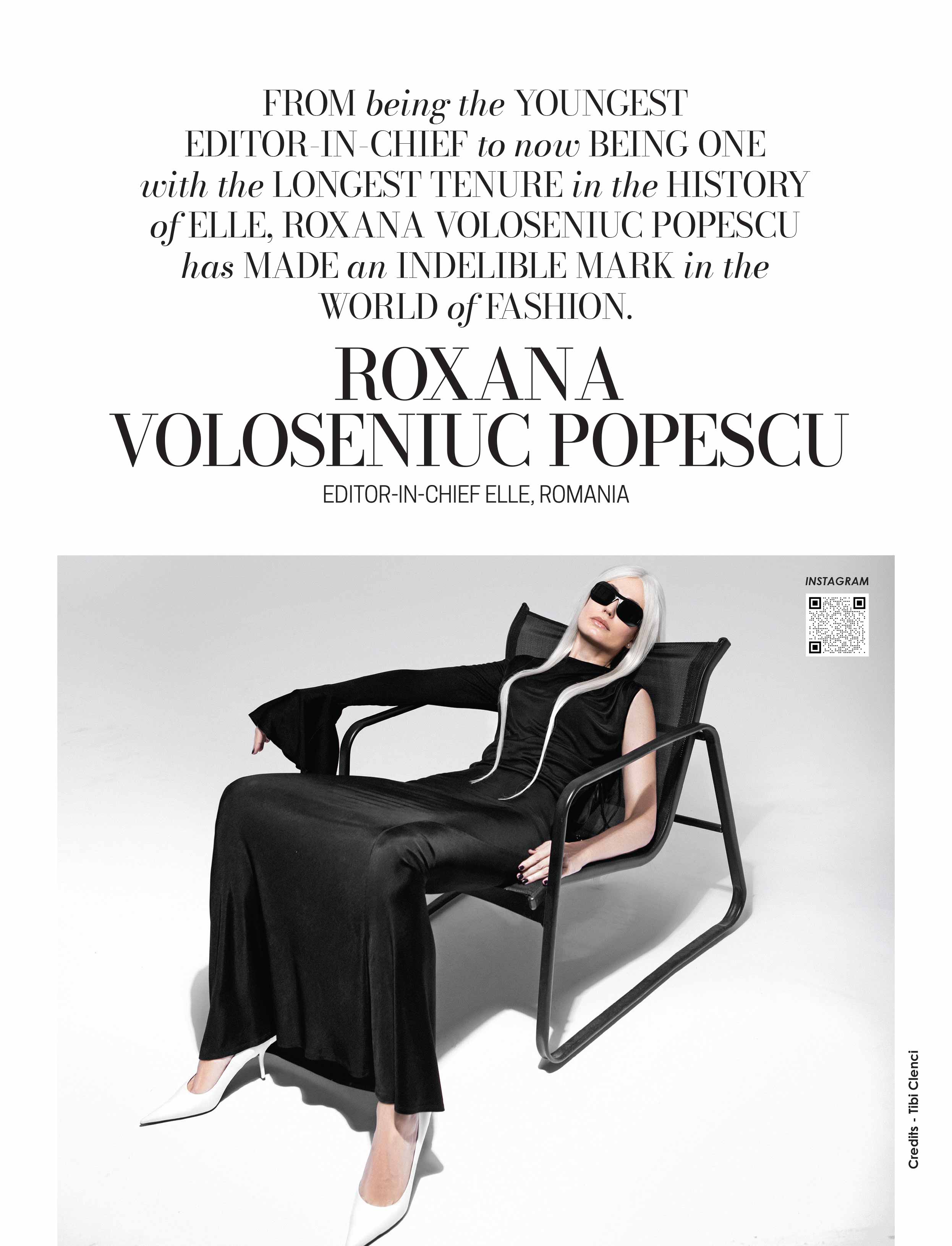
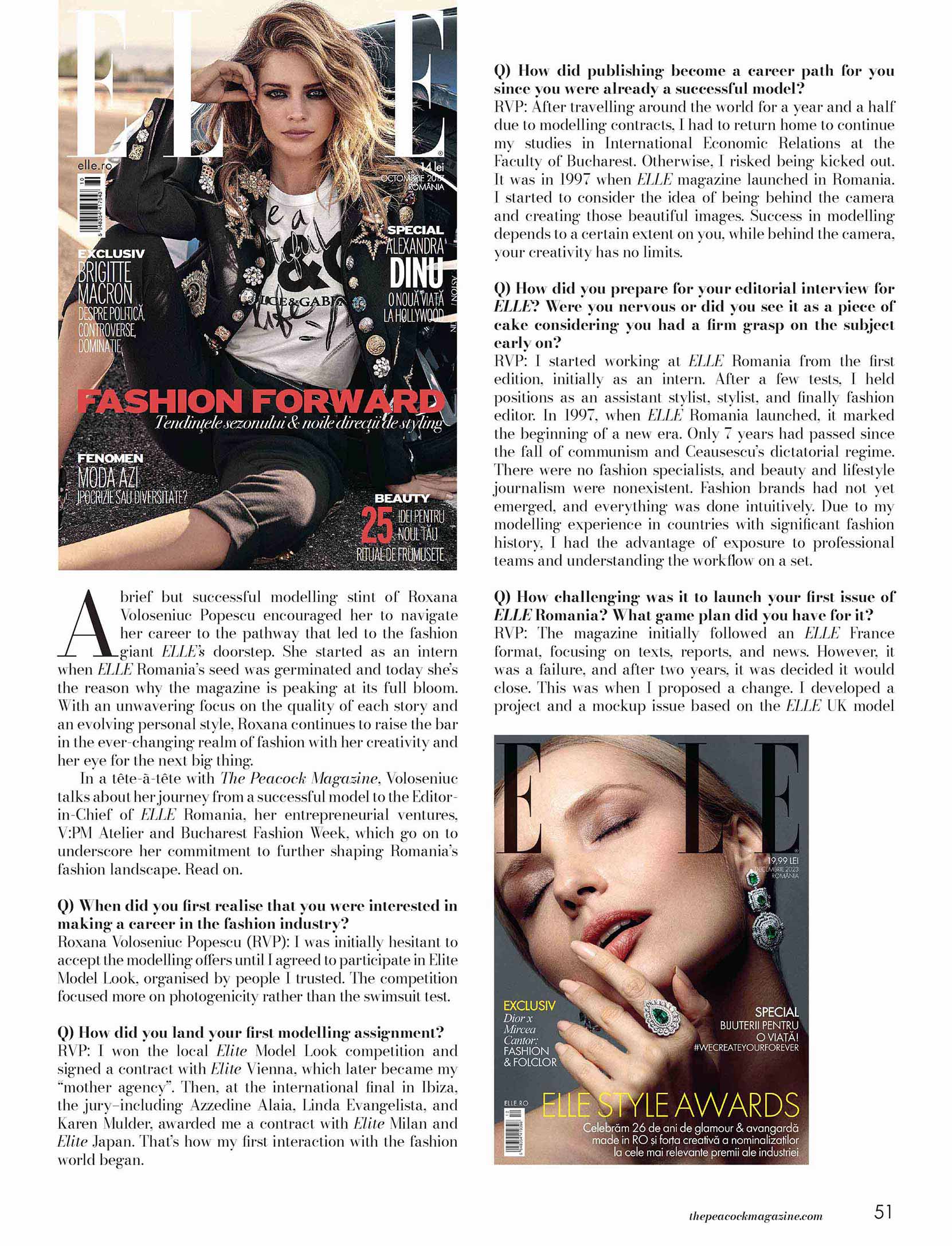
CREDITS – All images sourced from Roxana Voloseniuc Popescu
From being the youngest editor-in-chief to now being one with the longest tenure in the history of ELLE, Voloseniuc has made an indelible mark in the world of fashion.
A brief but successful modelling stint of Roxana Voloseniuc Popescu encouraged her to navigate her career to the pathway that led to the fashion giant ELLE’s doorstep. She started as an intern when ELLE Romania’s seed was germinated and today she’s the reason why the magazine is peaking at its full bloom. With an unwavering focus on the quality of each story and an evolving personal style, Roxana continues to raise the bar in the ever-changing realm of fashion with her creativity and her eye for the next big thing.
In a tête-à-tête with The Peacock Magazine, Voloseniuc talks about her journey from a successful model to the Editor-in-Chief of ELLE Romania, her entrepreneurial ventures, V:PM Atelier and Bucharest Fashion Week, which go on to underscore her commitment to further shaping Romania’s fashion landscape. Read on.
Q) When did you first realise that you were interested in making a career in the fashion industry?
I was initially hesitant to accept the modelling offers until I agreed to participate in Elite Model Look, organised by people I trusted. The competition focused more on photogenicity rather than the swimsuit test.
Q) How did you land your first modelling assignment?
I won the local Elite Model Look competition and signed a contract with Elite Vienna, which later became my “mother agency”. Then, at the international final in Ibiza, the jury–including Azzedine Alaia, Linda Evangelista, and Karen Mulder, awarded me a contract with Elite Milan and Elite Japan. That’s how my first interaction with the fashion world began.
Q) How did publishing become a career path for you since you were already a successful model?
After travelling around the world for a year and a half due to modelling contracts, I had to return home to continue my studies in International Economic Relations at the Faculty of Bucharest. Otherwise, I risked being kicked out. It was in 1997 when ELLE magazine launched in Romania. I started to consider the idea of being behind the camera and creating those beautiful images. Success in modelling depends to a certain extent on you, while behind the camera, your creativity has no limits.
Q) How did you prepare for your editorial interview for ELLE? Were you nervous or did you see it as a piece of cake considering you had a firm grasp on the subject early on?
I started working at ELLE Romania from the first edition, initially as an intern. After a few tests, I held positions as an assistant stylist, stylist, and finally fashion editor. In 1997, when ELLE Romania launched, it marked the beginning of a new era. Only 7 years had passed since the fall of communism and Ceausescu’s dictatorial regime. There were no fashion specialists, and beauty and lifestyle journalism were nonexistent. Fashion brands had not yet emerged, and everything was done intuitively. Due to my modelling experience in countries with significant fashion history, I had the advantage of exposure to professional teams and understanding the workflow on a set.
Q) How challenging was it to launch your first issue of ELLE Romania? What game plan did you have for it?
The magazine initially followed an ELLE France format, focusing on texts, reports, and news. However, it was a failure, and after two years, it was decided it would close. This was when I proposed a change. I developed a project and a mockup issue based on the ELLE UK model and presented them to the company owners. My idea was to create a more glossy version that would appeal to an audience eager for glam, shine, and beauty after decades of Communist darkness. The management was delighted with the proposal and arranged for me to have an interview with Hachette Filipacchi, the licensee of ELLE, in Paris. After a series of interviews, I managed to convince them to give the magazine another chance, and thus, I fulfilled my dream and also became the youngest editor-in-chief in the history of ELLE International. To this day, I also hold the record for being the longest-serving editor-in-chief of ELLE.
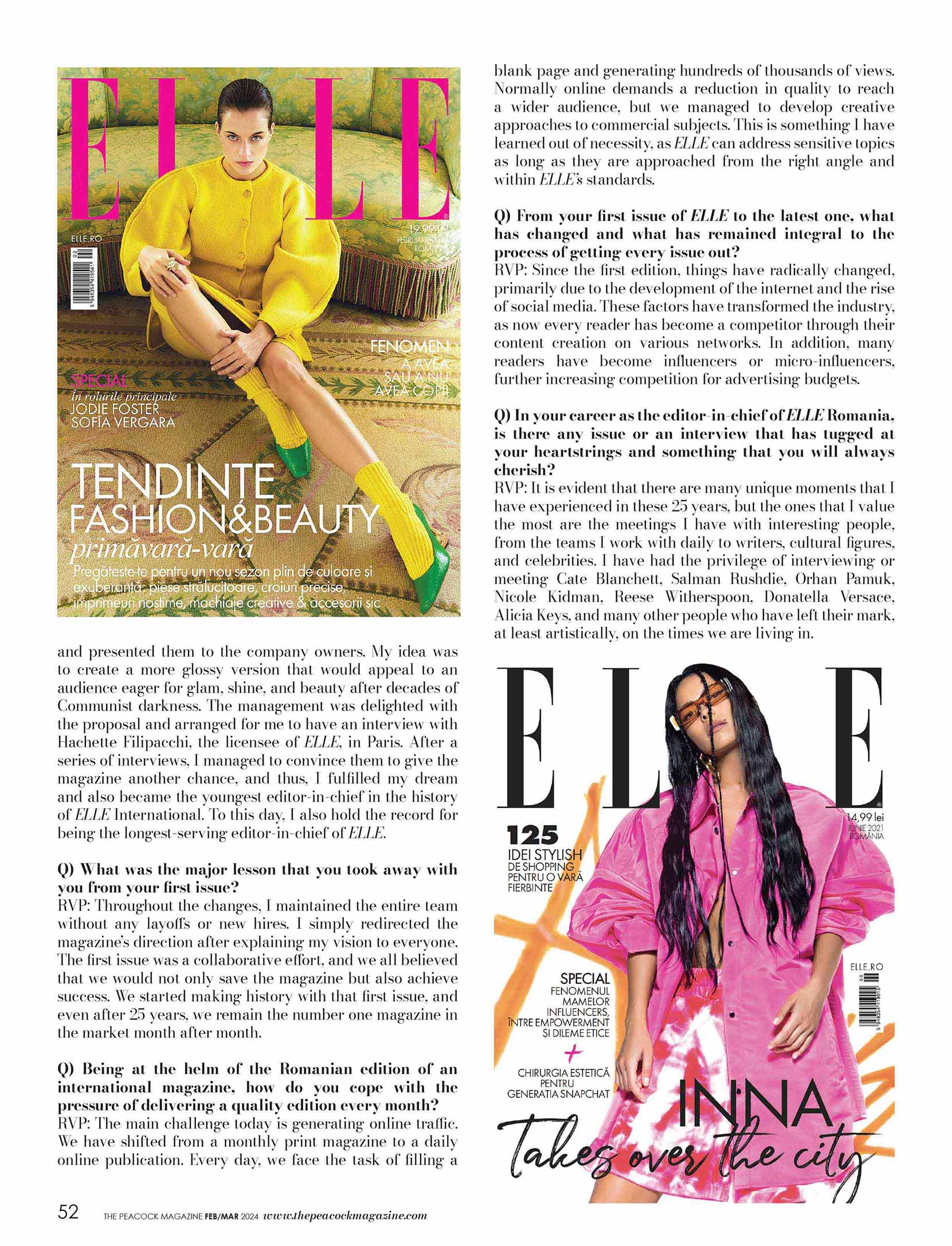
Q) What was the major lesson that you took away with you from your first issue?
Throughout the changes, I maintained the entire team without any layoffs or new hires. I simply redirected the magazine’s direction after explaining my vision to everyone. The first issue was a collaborative effort, and we all believed that we would not only save the magazine but also achieve success. We started making history with that first issue, and even after 25 years, we remain the number one magazine in the market month after month.
Q) Being at the helm of the Romanian edition of an international magazine, how do you cope with the pressure of delivering a quality edition every month?
The main challenge today is generating online traffic. We have shifted from a monthly print magazine to a daily online publication. Every day, we face the task of filling a blank page and generating hundreds of thousands of views. Normally online demands a reduction in quality to reach a wider audience, but we managed to develop creative approaches to commercial subjects. This is something I have learned out of necessity, as ELLE can address sensitive topics as long as they are approached from the right angle and within ELLE’s standards.
Q) From your first issue of ELLE to the latest one, what has changed and what has remained integral to the process of getting every issue out?
Since the first edition, things have radically changed, primarily due to the development of the internet and the rise of social media. These factors have transformed the industry, as now every reader has become a competitor through their content creation on various networks. In addition, many readers have become influencers or micro-influencers, further increasing competition for advertising budgets.
Q) In your career as the editor-in-chief of ELLE Romania, is there any issue or an interview that has tugged at your heartstrings and something that you will always cherish?
It is evident that there are many unique moments that I have experienced in these 25 years, but the ones that I value the most are the meetings I have with interesting people, from the teams I work with daily to writers, cultural figures, and celebrities. I have had the privilege of interviewing or meeting Cate Blanchett, Salman Rushdie, Orhan Pamuk, Nicole Kidman, Reese Witherspoon, Donatella Versace, Alicia Keys, and many other people who have left their mark, at least artistically, on the times we are living in.
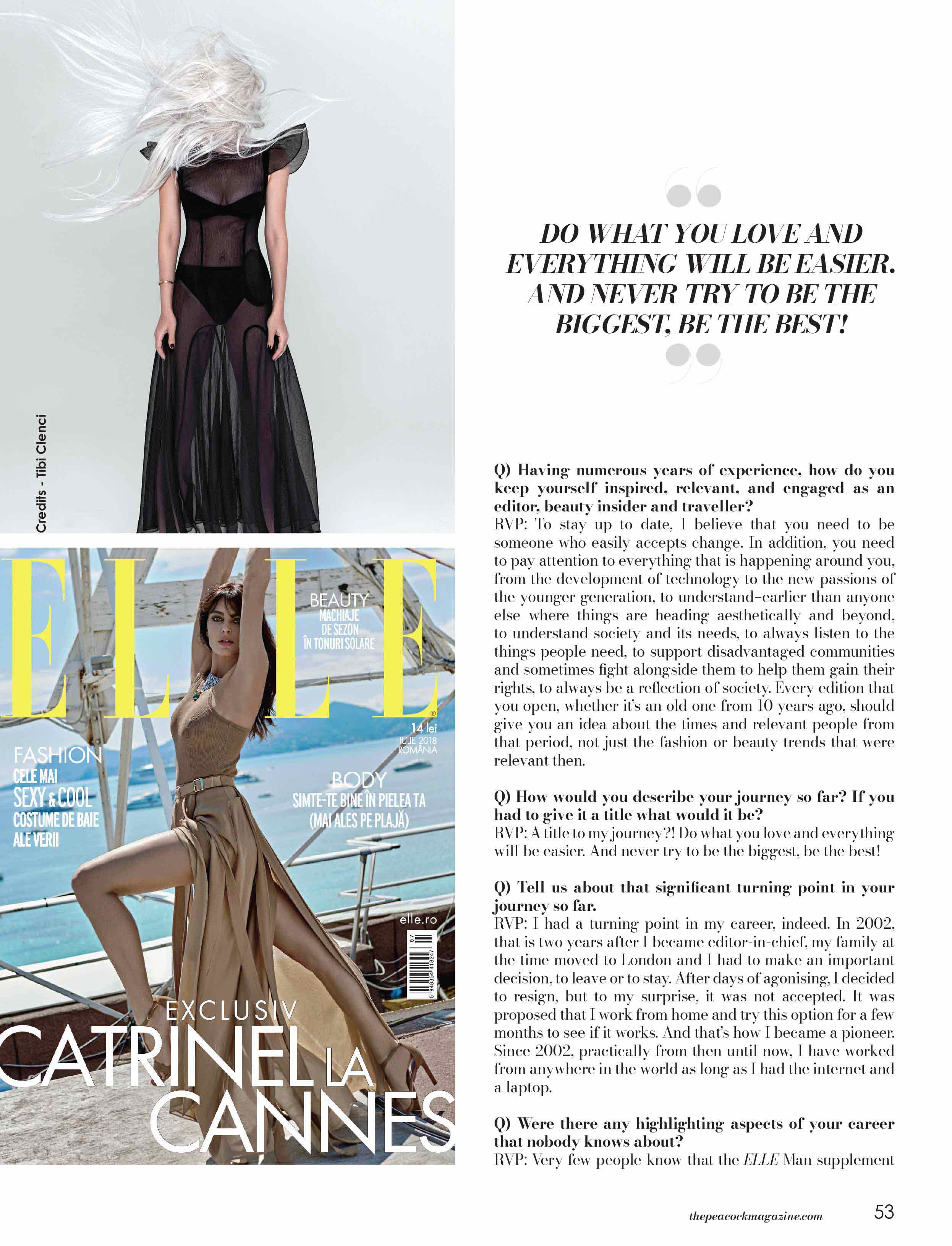
Q) Having numerous years of experience, how do you keep yourself inspired, relevant, and engaged as an editor, beauty insider and traveller?
To stay up to date, I believe that you need to be someone who easily accepts change. In addition, you need to pay attention to everything that is happening around you, from the development of technology to the new passions of the younger generation, to understand–earlier than anyone else–where things are heading aesthetically and beyond, to understand society and its needs, to always listen to the things people need, to support disadvantaged communities and sometimes fight alongside them to help them gain their rights, to always be a reflection of society. Every edition that you open, whether it’s an old one from 10 years ago, should give you an idea about the times and relevant people from that period, not just the fashion or beauty trends that were relevant then.
Q) How would you describe your journey so far? If you had to give it a title what would it be?
A title to my journey?! Do what you love and everything will be easier. And never try to be the biggest, be the best!
Q) Tell us about that significant turning point in your journey so far.
I had a turning point in my career, indeed. In 2002, that is two years after I became editor-in-chief, my family at the time moved to London and I had to make an important decision, to leave or to stay. After days of agonising, I decided to resign, but to my surprise, it was not accepted. It was proposed that I work from home and try this option for a few months to see if it works. And that’s how I became a pioneer. Since 2002, practically from then until now, I have worked from anywhere in the world as long as I had the internet and a laptop.
Q) Were there any highlighting aspects of your career that nobody knows about?
Very few people know that the ELLE Man supplement was our idea. Now many other editions publish ELLE Man supplements and even stand-alone issues, but we were the first! Other reasons for joy are the ones in which major editions such as ELLE France or ELLE China create their covers with images produced by ELLE Romania. Then there is the fact that the best-selling book in Romania is a book that includes 90% of texts previously published in ELLE where the author, the famous writer Mircea Cartarescu, signed an opinion page for a few years.
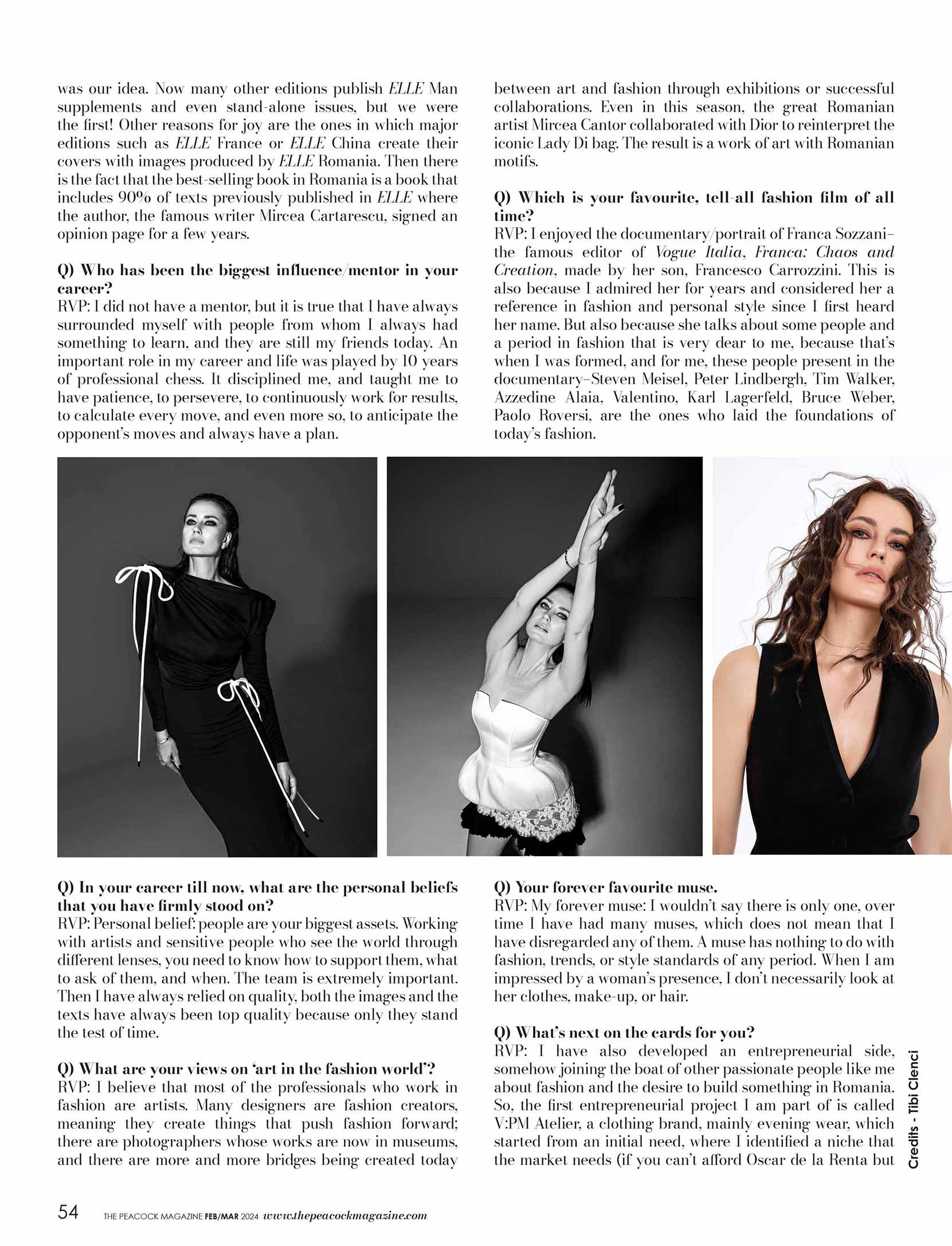
Q) Who has been the biggest influence/mentor in your career?
I did not have a mentor, but it is true that I have always surrounded myself with people from whom I always had something to learn, and they are still my friends today. An important role in my career and life was played by 10 years of professional chess. It disciplined me, and taught me to have patience, to persevere, to continuously work for results, to calculate every move, and even more so, to anticipate the opponent’s moves and always have a plan.
Q) In your career till now, what are the personal beliefs that you have firmly stood on?
Personal belief: people are your biggest assets. Working with artists and sensitive people who see the world through different lenses, you need to know how to support them, what to ask of them, and when. The team is extremely important. Then I have always relied on quality, both the images and the texts have always been top quality because only they stand the test of time.
Q) What are your views on ‘art in the fashion world’?
I believe that most of the professionals who work in fashion are artists. Many designers are fashion creators, meaning they create things that push fashion forward; there are photographers whose works are now in museums, and there are more and more bridges being created today between art and fashion through exhibitions or successful collaborations. Even in this season, the great Romanian artist Mircea Cantor collaborated with Dior to reinterpret the iconic Lady Di bag. The result is a work of art with Romanian motifs.
Q) Which is your favourite, tell-all fashion film of all time?
I enjoyed the documentary/portrait of Franca Sozzani–the famous editor of Vogue Italia, Franca: Chaos and Creation, made by her son, Francesco Carrozzini. This is also because I admired her for years and considered her a reference in fashion and personal style since I first heard her name. But also because she talks about some people and a period in fashion that is very dear to me, because that’s when I was formed, and for me, these people present in the documentary–Steven Meisel, Peter Lindbergh, Tim Walker, Azzedine Alaia, Valentino, Karl Lagerfeld, Bruce Weber, Paolo Roversi, are the ones who laid the foundations of today’s fashion.
Q) Your forever favourite muse.
My forever muse: I wouldn’t say there is only one, over time I have had many muses, which does not mean that I have disregarded any of them. A muse has nothing to do with fashion, trends, or style standards of any period. When I am impressed by a woman’s presence, I don’t necessarily look at her clothes, make-up, or hair.
Q) What’s next on the cards for you?
I have also developed an entrepreneurial side, somehow joining the boat of other passionate people like me about fashion and the desire to build something in Romania. So, the first entrepreneurial project I am part of is called V:PM Atelier, a clothing brand, mainly evening wear, which started from an initial need, where I identified a niche that the market needs (if you can’t afford Oscar de la Renta but still want to be elegant and cool, then the options are very limited) and slowly we reached Farfetch and started selling in markets other than Romania.
A second project I got involved in is Bucharest Fashion Week, which will have its first edition on October 16-17, 2024. This is definitely the project of my life. It is something I want to see happen in Romania, and the fact that I am personally involved comes second. The first edition will only last two days, and designers from Romania, Ukraine, Moldova, and Poland will be invited. With time, I would like Bucharest to become a regional fashion hub, and we are already working towards this goal from the first edition.

Q) You have seen countless trends come and go, countless fashion fads taking over the masses, and countless styles come and prevail. What would you say is the current personal style of Roxana?
Personal style: my whole life I always tried to avoid excesses of any kind.
Q) How has your style evolved over the years?
I don’t go for trendy or tight clothing, and I prefer a more natural and moderate look. I would say my style is classically elegant with fashionable touches. So, I don’t dress in a trendy way, but I also don’t look like I’m in high school. However, working in the fashion and beauty industry, you can’t help but be influenced by modernity and trends. When I dress up, I may unintentionally choose something that has a fashionable look, but that is never my intention. On another note, I am currently 48 years old, and I feel that if I don’t experiment now, I might regret it later. I don’t believe in “dressing according to your age”, but I do believe that the limitations should be based on how you feel and not on preconceived notions.
Q) What are your three essentials for any kind of vacation?
When I go on vacation, I always make sure to pack a swimsuit, a pair of flip-flops, and a book. Whether it’s summer and I’ll be spending time on the beach under an umbrella, or it’s winter and I’ll be relaxing at a spa after a day of skiing, these items are always essential. Other than that, I try to pack as minimally as possible. Even though I no longer travel with just a small suitcase (I did that for a whole year during the pandemic when many flights were cancelled), I still aim to limit the amount of clothes I bring on vacation.
Q) What’s your list of fashion ‘‘ins’’ and “outs” for 2024?
I was convinced that the fashion system would undergo a radical transformation after the COVID-19 pandemic. There were initial signs of change, but over time, we returned to the same fast-paced industry. Production is at an accelerated rate, and the pressure on brands and designers is back to pre-pandemic levels. However, I am glad to see that there is a growing emphasis on sustainability. This is not just a passing trend, but a change demanded primarily by consumers, especially the new generation who are not only concerned about how clothes fit them, but also about the role that brands they support play in society.
